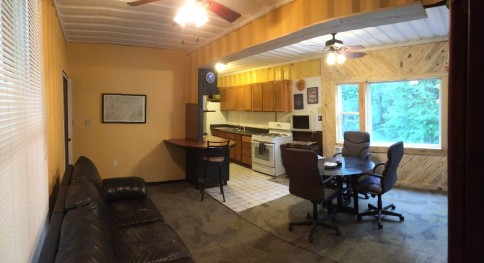Back in 2011, I finished my tiny guest house, built out of two forty-foot CONEX shipping containers. It’s a comfortable, fully functional house with one-bedroom + sleeping loft, a large kitchen, living area, full bath, laundry and extra storage. I was pleased with the results. You can read my original post, including my floor plan design and original photos at Build a Great House for under $10,000.
We used it mostly for convenience and for family and friends that would visit from time to time. Over the years, I couldn’t resist making lots of improvements. That, of course added cost, but it has been so worth it.
My latest improvements included:
- A generous covered deck with deck chairs and a large gas barbecue that overlooks our little pond, filled with catfish, bass and croaking bullfrogs.
- Covered parking for one vehicle in addition to the carport that handles four of ours.
- French doors opening onto the covered deck
- Newly Steel Framed Massive windows looking out into the woods and creek behind the house. The house is so much more bright and cheery.
- Fresh, natural re-sawn pine wood paneling in the living / dining area. Wood is so much more cozy than corrugated steel.
- New Kitchen Cabinet faces
- A kitchen bar, re-purposed from a big oak conference room table salvaged from my days at Baskin-Robbins corporate.
- A new heat pump that cools and removes humidity in the summer and makes the place toasty warm in winter. The original low cost insulation, added to the exterior under the wood siding, has been great.
- A gas fireplace for some extra cozy when “the weather outside is frightful”.
A few months ago, we began offering the space for short-term rental on Airbnb. The response has been amazing. You can see the listing at Mountain Waterfall Cabin in Eco-Village
We also listed another one bedroom log cabin at Log Cabin on Miller’s Falls
The experience hosting and getting to know lots of great people has been fabulous. Many of the improvements were prompted by suggestions from guests. It’s still a work in progress. Between guest visits, I can usually be found either making improvements to one of these two houses or making plans for the Village 2.0. that I’m calling the “Enchanted” Village on Sewanee Creek, or Enchanted Village for short. I’ll write more about that later.
So, if you are interested in seeing what it might be like to live in a tiny home or a container house built from Conex shipping containers, come stay with us in one of our comfortably small houses. While here, I’ll be happy to give you a tour of the Village on Sewanee Creek. You can meet some of our self-reliant Villagers and learn about rainwater catchment systems, off-grid solar, bee-keeping, gardening, the benefits of chickens (even harvest some fresh eggs for breakfast), Ham radio communications, raising mushrooms or foraging for edible woodland foods, the slower, more satisfying life-style we enjoy here and much more.
Wander over to the amphitheater and enjoy a cookout in the fire pit under the satellite dish gazebo. If you are a singer/song-writer or musician, this is the perfect place for a songwriter’s retreat. How about an awesome place in nature to perform for a few appreciative music-lovers. Our amphitheater offers a great outdoor stage with a covered backstage. You can book it for free (as long as Villagers are invited to enjoy your music). I’ll take you on a tour of the surrounding area where you will meet the rangers at the Visitor’s center and arrange for a guided hike through one of our eight nearby state parks.
Take a short walk along the creek to the top of fifty-foot Miller’s falls. Then follow the gentle trail to the bottom of the falls. Go behind the falls and enjoy contemplating God’s wonders on the natural stone bench in the grotto.
If you enjoy the unique satisfaction of being creative and building things, I can always use an extra pair of hands in the wood and welding shop. By the way, I’m looking forward to many more years building tree houses in the enchanted village and love to share creative ideas with others who are similarly motivated by the urge to create magical things.








